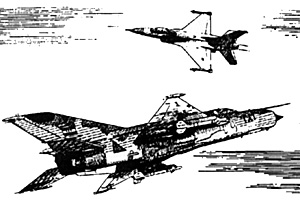 The coalition air order of battle effectively consists of
thirteen separate air forces from 10 countries. I consider the
USAF, USMC, US Army aviation, and Carrier based airpower
as separate entities. This is a commander's nightmare and
doesn't even begin to consider what would happen if the
Turks, Syrians, Omanis, and Israelis decide to add their two
cents worth.
The coalition air order of battle effectively consists of
thirteen separate air forces from 10 countries. I consider the
USAF, USMC, US Army aviation, and Carrier based airpower
as separate entities. This is a commander's nightmare and
doesn't even begin to consider what would happen if the
Turks, Syrians, Omanis, and Israelis decide to add their two
cents worth.
Having 2,000 aircraft on the scene sounds great but the very size of the coalition's air power hinders its effectiveness. First, one must consider that the British, French, and American forces are not under a single command. That means British and French air power will be off on their own although the Brits will likely be kind enough to coordinate activities with us on a daily basis. The independently minded French are likely to use their air power strictly in support of their own ground forces although they might surprise me.
You can expect Qatar, Oman and United Arab Emirate aircraft to stay in the background simply defending their home territory from raids that will never come. They are not keen on attacking brother Arabs but don't mind watching Westerners do so from their bases. The Saudi Air Force is large and will likely conduct some joint operations with U.S. aircraft but they will restrict themselves simply to liberating Kuwait and in the safest possible manner. No sense getting killed if the Americans will do the honors for you. Only the Kuwaiti Air Force in exile can be expected to be motivated to put in a spirited attack to regain their homeland but beyond that: no help. The Canadians might conduct offensive operations if their government approves it, but for now they too are simply in a defensive posture.
In order to supply some modicum of control, the air war will be conducted by limiting various units of aircraft to specific sectors and time slots during the day. This was done in Vietnam by dividing it up into "route-packs". A similar division will probably be made in the gulf with specific areas of responsibilities being assigned separately to the Navy, Marines and Air Force. Specific targets might be assigned to one service or another or to that of a separate country in sectors not normally covered by that entity but only during specific time slots when none of the aircraft normally assigned to that sector will be there.
To maintain control, it is essential that almost every strike or raid be pre-planned and coordinated in advance. E-3A AWACS, Saudi GCI stations, Navy E-2 Hawkeyes, picket ships, and ground FACs will have the responsibility of playing traffic cop to the hordes of aircraft shuffling to the targets and back. Checkin procedures will be extensive with aircraft formations staging at holding point:, awaiting their turn in. Air Defense will also be rigidly structured with F-15s and Tornado F.3s holding at high altitude in specified CAP stations with others assigned as strip alert. Hawk and Patriot SAM battery envelopes will basically be no-fly areas due to the difficulty of coordinating the passage of friendly aircraft through their defense zones or will be shut down during periods when friendly aircraft are overhead.
Large raids will be easy to control going in but sorting out the dozens of scattered pairs and singletons that will be returning after a large attack from pursuing Iraqi aircraft will be tough.
Fratricide is highly likely in the initial days while there is still an Iraqi Air Force and while allied Air Defense units are still trigger happy. The Visual I.D. before you shoot rule of engagement will be back and will apply most of the time. Only closely controlled interceptors vectored against confirmed Iraqi aircraft, or aircraft participating in fighter sweeps early on, before the skies over Kuwait resemble those over Kennedy International, will have the luxury of firing BVR in an engagement. Fratricide against allies is possible as well since the Iraqi's fly Mirage F.1s as do the French and many others in the region.
The Israelis have expressed a desire to coordinate with U.S. forces in the gulf but have been ignored due to politics and the desire to keep our Arab allies. Having unidentified aircraft, even if supposedly friendly, suddenly get mixed up over Iraq with U.S. aircraft is a potential disaster in the making, but a risk we've decided to take.
Competent Iraqi pilots will find themselves in a classic target ri,- h environment. Lesser capable Iraqi pilots will become statistics or martyrs against the masses of allied aircraft. Allied pilots and crews will be very busy and will pay a heavy price bringing Iraq to its knees but once they do, the coalition ground forces should have an easy time finishing the Iraqi army in Kuwait off. Hopefully it will all end quickly. Maybe Saddam will get bumped and the new leader will call for peace early on, who knows.
Nevertheless, to an aviation historian like myself, seeing air power applied on such a massive scale and in a seemingly correct manner is fascinating. My eyes are wide open! Hopefully yours are too.
Air War Over Iraq 1991
Back to Table of Contents -- Air Power # 13
Back to Air Power List of Issues
Back to MagWeb Magazine List
© Copyright 1990 by J.D. Webster
This article appears in MagWeb.com (Magazine Web) on the Internet World Wide Web.
Other articles from military history and related magazines are available at http://www.magweb.com